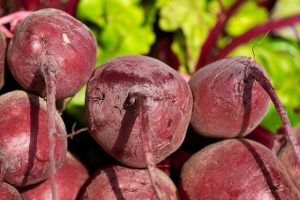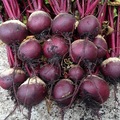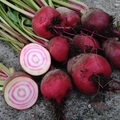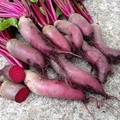♥ Easy to grow, tasty and very versatile. Growing beetroot couldn’t be easier.
♥ Lift young as ‘baby beets’ or leave to mature
♥ Excellent source of folate and good source of potassium.
The roots are sweet and ideal for roasting, pickling or just slicing in salads. They are exceptional when pickled and can be tried in a variety of vinegars. We’ve used apple cider vinegar but malt vinegar is equally tasty especially in the run up to cold winter months.

Sowing
Sow outdoors where they are to grow and crop, about 2.5 cm (1 in. apart) deep directly into finely prepared soil which has already been watered. Allow 30 cm (1 foot) between rows. Plants grow to 40cm height. The best time to sow is between April and July with their final growth period around October.
Any seed sown before then, say around early March is best grown under a cloche. Protect young plants with fleece to prevent losses through cold.
The seeds germinate at 13°C and above. Make sure they are covered on sowing. A cloche also helps to protect the young seedlings.
Seedlings usually appear in 7-21 days.
Thinning Out Beetroot Seedlings
Thin seedlings to 10 cm (4in) apart. Water well until plants are established. Dry soil will lead to woody roots, so water well and make sure the soil is always moist. Leaving some room between the beets means the roots can develop without constriction. If you sow more thickly than 7 cm (3in) between roots, just thin ourt the seedlings until an optimum spacing is achieved. Some growers like to take the thickest globes and then leave the rest to grow as and when required.
Ideally, sow a few seeds in short rows every couple of weeks throughout the season to get a continuous harvest. The last sowings will produce a harvest for winter.
Do not allow the beets to grow too large otherwise they lose their flavour and become woody. We think a size of a golf ball is best although a little bigger is possible. Do not grow to the size of a rugby ball as these are far too woody.
Keep the plants watered in very dry periods but do not overwater. This encourages leaf growth rather than root growth. Frankly, watering is a bit hit and miss so it comes down to trial and error in deciding when to water.
Harvested roots can be stored in dry sand or dry compost for winter use. Lift the crop around the last months of autumn.
Salad Leaves
The young baby leaves of the beetroot can be harvested and added to salads.
Not frost hardy.
Cultivars:

Boltardy remains the standard popular beetroot mainly because as its name suggests, it does not bolt (running to flower and seed) and does not form small woody beets either. A good variety for early sowing as well. The beets are round with strong deep red colour and of very high quality. It is ideal as a bulk grown vegetable before switching to another later variety such as Pablo. Sown little from March onwards and often for picking over several months from June onwards.

Chioggia is a traditional Italian globe beetroot with unusual red and white rings when its cut surfaces are exposed. It has dark green leaves and deep red stems. Very attractive for salad and dinner plate with sweet flavour. Sow little and often and you will be picking the roots over several months from end of June onwards.

Cylindrica is as its name suggests produces a long, slim, cylindrical shaped beetroot, with a dark red colour to both the outer smooth skin and the inner sweet tasting flesh. Great for slicing.
Detroit 2 (Crimson Globe) .. a good round rooted variety for both maturing and baby beet production.
Pablo – grown for its ‘baby beet’ potential. Has smooth skin and good deep red internal colouring. Also sown after the variety ‘Boltardy’ has finished. Sow little and often and you will be picking the roots over several months from July onwards.
Seeds
Please note this page contains links to our affiliate marketing partners like Amazon and Paid On Results. Please read our affiliate disclosure.
Why not try Simply Seed and Kings Seeds for a varied source of seeds.
Leave a Reply